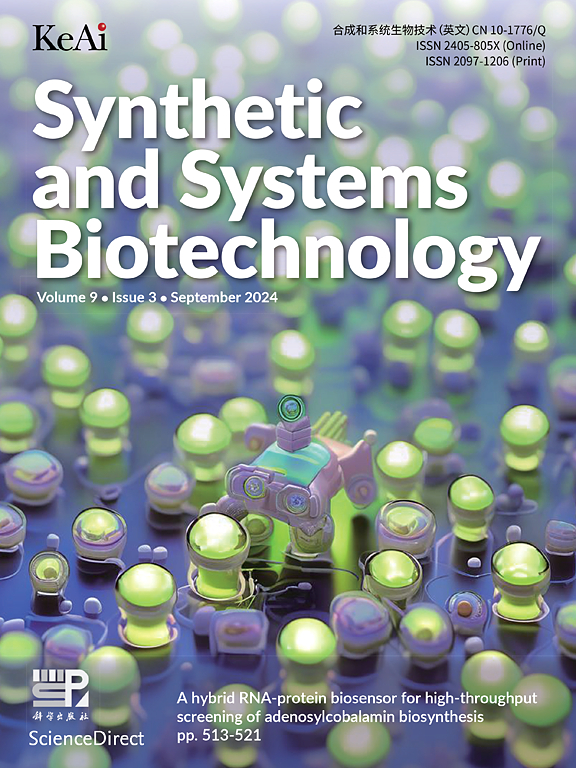人工CO2同化途径的系统设计与评价
IF 4.4
2区 生物学
Q1 BIOTECHNOLOGY & APPLIED MICROBIOLOGY
引用次数: 0
摘要
随着工业和生物农业的发展,二氧化碳的有效管理已成为人类面临的严峻挑战。本研究采用comb-FBA算法系统探索多种CO2同化途径,旨在识别高效的人工固碳途径。通过提取49个涉及CO2和HCO3−的反应,并将其与MetaCyc中的6,529个反应相结合,我们构建了用于分析的计算集。这16个核心反应产生了单个C2目标(如乙酰辅酶a、乙醛酸酯和草酸酯)的136个碳固定途径和单个C3目标(包括甘油醛-3-磷酸或丙酮酸酯)的576个碳固定途径。基于这些核心反应,我们确定了四种主要的碳固定模式。通过系统评估,我们确定了12种有希望的二氧化碳固定途径,每个途径不超过20个反应步骤,并证明了热力学可行性。通过进一步分析酶的氧敏感性和可用性,我们确定了三个新的和有前途的途径。通过研究代谢物转化关系,我们还确定了可替代的碳固定反应模块,为途径优化和实验设计提供了灵活性。总之,本研究提供了一个多样化的人工碳固定途径库,证明了梳子- fba算法在设计碳同化途径方面的强大功能,为更有效的二氧化碳固定策略奠定了基础。本文章由计算机程序翻译,如有差异,请以英文原文为准。
Systematic design and evaluation of artificial CO2 assimilation pathways
With the advancement of industry and bio-agriculture, the effective management of CO2 has emerged as a critical challenge for humanity. This study systematically explores multiple CO2 assimilation pathways using the comb-FBA algorithm, aiming to identify efficient artificial carbon fixation pathways. By extracting 49 CO2 and HCO3− involved reactions and combining them with 6,529 reactions from MetaCyc, we constructed the computational set for analysis. These 16 core reactions give rise to 136 carbon fixation pathways for single C2 targets (such as acetyl-CoA, glyoxylate, and oxalate) and 576 carbon fixation pathways for single C3 targets (including glyceraldehyde-3-phosphate or pyruvate). Based on these core reactions, we identified four principal carbon fixation modes. Through systematic assessments, we identified 12 promising CO2 fixation pathways, each comprising no more than 20 reaction steps and demonstrating thermodynamic feasibility. Through further analysis of enzyme oxygen sensitivity and availability, we identified three novel and promising pathways. By examining metabolite conversion relationships, we also identified alternative carbon fixation reaction modules, offering flexibility for pathway optimization and experimental design. In conclusion, this study provides a diverse library of artificial carbon fixation pathways, demonstrating the power of the comb-FBA algorithm in designing carbon assimilation pathways and laying the foundation for more efficient CO2 fixation strategies.
求助全文
通过发布文献求助,成功后即可免费获取论文全文。
去求助
来源期刊

Synthetic and Systems Biotechnology
BIOTECHNOLOGY & APPLIED MICROBIOLOGY-
CiteScore
6.90
自引率
12.50%
发文量
90
审稿时长
67 days
期刊介绍:
Synthetic and Systems Biotechnology aims to promote the communication of original research in synthetic and systems biology, with strong emphasis on applications towards biotechnology. This journal is a quarterly peer-reviewed journal led by Editor-in-Chief Lixin Zhang. The journal publishes high-quality research; focusing on integrative approaches to enable the understanding and design of biological systems, and research to develop the application of systems and synthetic biology to natural systems. This journal will publish Articles, Short notes, Methods, Mini Reviews, Commentary and Conference reviews.
 求助内容:
求助内容: 应助结果提醒方式:
应助结果提醒方式:


